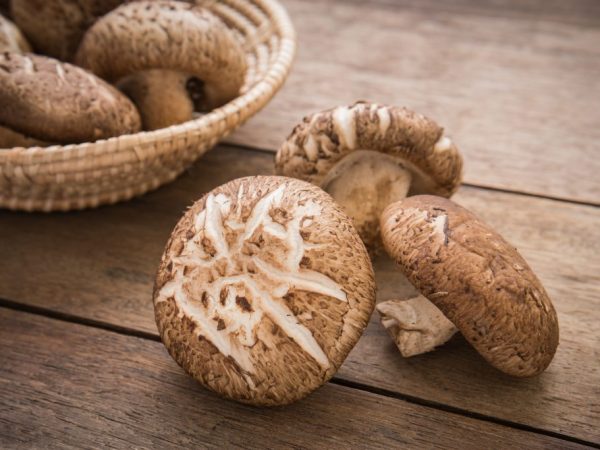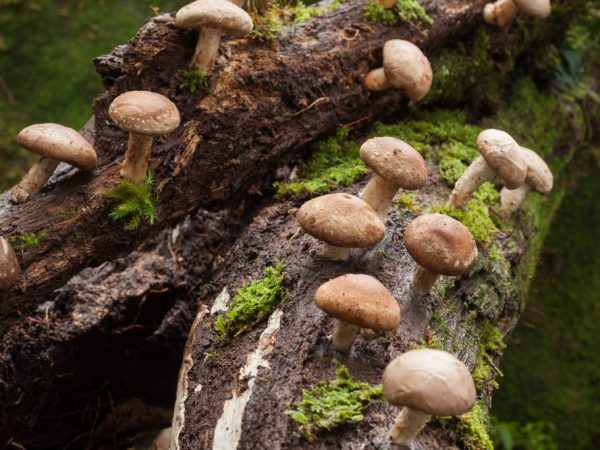Features of shiitake mushrooms
Shiitake mushrooms are amazing representatives of the mushroom kingdom, used both in cooking and for the treatment of various diseases for many years. In the East, this legendary mushroom has been popular for more than two millennia and is considered a symbol of longevity and health. It can also be successfully grown at home.

Features of shiitake mushrooms
Description and distribution of the fungus
Shiitake mushrooms, also called shiitake, are widespread in the Far East. Over their two thousand year history, they have gained fame as "imperial mushrooms", being a popular component of the menu exclusively of the rulers of China and Japan.
Shiitake is an edible representative of the genus Lentinula, it is a saprophytic macromycete, because uses organic matter of dead plants for nutrition. It has a lamellar cap of a dark brown color, with a diameter of 5 to 20 cm. The plates themselves are thin, covered in young fruiting bodies with a membrane, if damaged, they almost immediately change their shade to dark brown. The surface of the cap looks dry with nubs and cracks. In young individuals, the edges of the cap have a flatter shape, and with age they become bent. This sign will tell the attentive buyer about the age of the mushroom.
Its leg is straight, light brown, slightly narrowed at the base, fibrous, 3-19 cm long. The flesh is white, fleshy in its structure and quite dense, with a sharp taste and pleasant aroma. The weight of one mushroom ranges from 90-100 grams.
The shiitake tree fungus grows naturally in Southeast Asia on fallen deciduous trees, old stumps. In the Russian Far East, it grows most often on dead oak and linden wood. Fruiting from spring to late autumn, growing from small to mature in 6-8 days.
It has similar counterparts among the Champignon family, which, unlike it, grow on soil.
Useful properties and contraindications
Imperial mushrooms are healthy, have excellent taste, high nutritional value and have an optimal KBZHU. The calorie content of the product is 34 kcal, and 100 g of unprocessed product contains 2.2 g of proteins, 0.5 g of fat and 6.8 g of carbohydrates.
Shiitake mushrooms are also useful due to their high content of all kinds of vitamins and microelements. The product is a source of vitamins B, C and D. Contains iron, calcium, phosphorus, potassium, zinc, selenium and other minerals. It is rich in amino acids, plant hormonal substances and polysaccharides, coenzymes capable of exerting powerful antitumor, immunostimulating and antioxidant effects.
By its ability to increase the production of interferon in the human body, this mushroom is on a par with ginseng.
Fresh shiitake caps are highly prized in cooking, the fibrous stem is less tender and less tasty. In the homeland of shiitake, it is processed immediately after harvest in order to preserve its taste and smell. In Europe, they prefer to use dried or frozen edible fruit bodies in their dishes. Soups, side dishes are prepared from them, fried, salted, pickled and served as a delicacy.
Chinese shiitake mushrooms, under certain conditions, can harm the human body, therefore, they have a number of contraindications:
- are able to provoke attacks of bronchial asthma or allergies, therefore they are not recommended for use by people with such health problems;
- during pregnancy, this product is able to change the hormonal background of a woman and thereby cause harm, and during breastfeeding it has the ability to penetrate into breast milk, provoking a child's digestive upset;
- contraindicated in children under 5 years of age, because can cause disturbances in the gastrointestinal tract;
- has contraindications for use at any age, because overloads the digestive tract with the indigestible substance chitin contained in it.
Application in medicine

Mushrooms Help Fight Cancer
It has been used in oriental medicine for several centuries. Modern fungotherapy uses medicinal preparations based on this product for many diseases and disorders in the human body:
- Stimulation of immunity: the polysaccharides it contains help produce interferon, which is essential for fighting disease.
- Lowering blood cholesterol levels: Japanese researchers have shown that daily consumption of shiitake for 7 days causes a 12% reduction in this component.
- Fight against oncology: is considered one of the means for the treatment of cancer patients, tk. the lentinan it contains helps fight cancer by forcing the body to stop the development of malignant cells.
- Treatment of cardiovascular diseases: the chemical composition helps to normalize blood pressure and dissolve cholesterol plaques, preventing vascular thrombosis.
- Combating diabetes mellitus and preventing its complications: the benefit of its chemical composition lies in the gradual increase in the production of insulin by the restored cells of the pancreas.
- Benefits for the liver: they tend to produce antibodies to fight hepatitis and restore human health.
Irina Selyutina (Biologist):
Research has shown that shiitake spores contain components that are identical in properties to the influenza virus. However, for humans, they are completely harmless. With regular use of this mushroom, they stimulate our body to produce interferon - a special protein that is an immunostimulant.
Dried shiitake mushrooms are widely used in Chinese and Japanese folk medicine. At home, a tincture is prepared from them. To do this, they are crushed, poured with alcohol and left for 21 days in a glass sealed container. Then the tincture is filtered and consumed in a dosage of 1 tbsp. l. 3 times a day before meals.
Shiitake mushroom extract is produced industrially. This medicinal preparation is added to dietary supplements, where the main active ingredients are the polysaccharide lentinan and lentinacin with a complex of amino acids and vitamins. The mushroom extract in the form of tablets is taken for a long time according to a certain scheme, strictly following the instructions and recommendations of doctors.
Another form of its use is shiitake capsules, which contain a highly concentrated medicinal extract from mushrooms. The capsules are also used as a dietary supplement to food. You can also take this miracle of nature like tea, using a soluble form of the drug. At the same time, its medicinal properties are not reduced, the doctor selects the optimal dose required for treatment.
Growing at home
Mushrooms with medicinal properties are used for cultivation, especially in Japan and China. They are cultivated on woody logs, creating a microclimate as close to natural as possible.
Shiitake grown on natural oak wood under natural light are practically indistinguishable from their wild-growing counterparts. Less medicinal, but cheaper, are fruit bodies grown at home on sawdust while maintaining the required moisture.
Cultivation technology on wood
Growing shiitake at home is quite possible with the observance of a certain technology, although this activity is laborious. They are grown in a garden using a DIY substrate. For this, dry wood is prepared from trunks, for example, oak, chestnut, beech, previously sawn into small bars 35-40 cm long.
Irina Selyutina (Biologist):
Attention! When preparing the substrate, the mushroom grower needs to take wood exclusively from hardwoods. This is due to the formation of resin and phenolic substances in the wood of coniferous plants, which can significantly slow down the development of mycelium, and therefore delay the time of harvesting.
If mushrooms are grown in the country, then it is convenient to plant mycelium in hemp that does not have putrefactive damage. With the arrival of spring, small holes with a depth of 5 to 7 cm and a diameter of up to 1 cm are made in the selected wood material, the distance between them should be equal to 7-8 cm. The holes are usually arranged in a checkerboard pattern. Then, for 3 days, it is soaked and excess moisture is allowed to drain. After that, the shiitake mycelium is planted in the holes, covered with a damp cotton swab from above and taken out into the street in a shaded place or in a room with sufficient humidity.
Growing shiitake in sawdust and straw
If it is not possible to grow them on wood, use dry sawdust or straw. To prepare the substrate, take sawdust from medium-sized deciduous trees or straw from barley or oats. For disinfection, they are boiled for 2-3 hours or filled with hot water for 6-8 hours, leaving the container closed. To increase the nutrient content of the substrate, you can add cereals, bran, and oat flour. The prepared mixture is transferred to a container. You can also use plastic bags as a container. After the substrate has cooled to 25 ° C, the mycelium is placed in it and covered, maintaining the required temperature and humidity, and transferred to a darkened room.
Caring for fruiting mycelium
Until germination, it is necessary to provide a constant microclimate with a temperature of 18-20 ° C during the day and 12-14 ° C at night. Then it is lowered to 14-16 ° C during the day and 10-12 ° C at night, respectively. The humidity level is maintained by periodically sprinkling the germination sites with water.
Such blocks with myceliums bear fruit for 3-6 months, then the mixture must be completely replaced. Growing on wood or hemp is allowed for 5-7 years until they become unusable.
Conclusion
The Chinese edible shiitake mushroom is an extraordinary product of nature and is very popular. Attention! The substrate that you intend to use for growing mushrooms should be as clean as possible, which means fresh, so that spores of pathogenic fungi and bacteria do not have time to settle in it, which can nullify all your efforts.
It is worth growing shiitake on your site to get a fresh, tasty and healing mushroom as a result. The use of mushroom extract in tablets and capsules is effective against cancer and other diseases.



